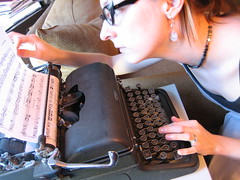We ran out of storage space for our earliest episodes. But fear not, we have made these many, many hours of freelance writing goodness available for just £10. If you want access to them all, please click Add to Cart and buy through our e-junkie account for instant access.

As a freelance writer, there are times when it is impractical or unrealistic to hire an external proofreader to check through everything you write. A full work of fiction or an entire book will, without question, require a professional proofreader and editor, but for 500 word articles or 700 word blog posts we need to be able to check and double-check our own writing to make sure that everything we submit is perfect.
In this solo episode, I discuss numerous tactics that can make this process much, much easier.
There are several ways to make sure that you don’t miss out on A Little Bird Told Me.
Find us on Stitcher Smart Radio
And finally, please ‘like’ us on Facebook to be the first to hear our news and to talk with us about what you hear on the podcast!
Show Notes
Armando Iannucci: Comedy Writing Tips
Transcript
How to proof-read your own work
Hello and welcome to episode 19 of A Little Bird Told Me, the freelance writing podcast that talks about the highs, the lows and the no-nos of successful self-employment.

Tune in every week to get news, views, opinions, tips and tricks about freelance writing, and find us online at alittlebirdtoldme.podomatic.com. If you go to that website, you can subscribe to the podcast by RSS feed, on iTunes or on Stitcher Smart Radio. And if you do that, you’ll be the first to hear when we have a new episode out. On that page, you can also find links to our Facebook page, and also to my own social media feeds and websites, and those of my co-host Lorrie. Although, speaking of my co-host Lorrie, she’s not here today as this is a solo episode. So you’re with me, Philippa Willitts, and I’m going to be talking about proof-reading your own work.
Now, if you do an extended piece of wiritng, be it a novel, a set of short stories, a book length non-fiction text or any considerable piece of work, then don’t even try and be your own proof-reader. It’s not realistic – nobody can successfully proof-read their own work when it’s a long, decent-sized text. You need a proof-reader, and an editor, and there’s no avoiding that.
However, when you’re a freelance writer, often a lot of what you do is smaller pieces of work for clients such as articles, press releases, website copy – there are a lot of different options that it’s just not realistic to expect to hire an external proof-reader for. If you’ve written 500 words as a news story for a client, sending it off to be proof-read, then getting it back, isn’t common practice.
But, proof-reading your own work, you still face some of the same problems with smaller pieces of work as you do with longer ones – it is really hard to look at your own work with fresh eyes, and that’s absolutely necessary if you’re going to proof-read successfully. A lot of freelance writers are also proof-readers as well – I am, and I know Lorrie is too – so it might seem strange to dedicate an episode to it when we already know how to do it. But when you’re doing it on your own writing rather than on someone else’s, you really do fae some different issues. When you read your own work, you’re familiar with it, so it’s easy to skip over words and phrases without even knowing you’re doing it. It might evem be that you think you’re reading it, but you’re actually remembering it and what’s in your head is what you remember writing, which was, of course, perfect! It’s only when you look at it with fresh eyes that you realise there’s an extra comma and, for some reason, you’ve capitalised a word in the middle of a sentence.

The place to start is with the spell-check in your word processor. Now, these are notoriously unreliable and they’re certainly not something you should rely on entirely. They don’t spot homophones, they don’t spot typos that are still words but not the word you intended. However, there’s no denying that looking over your work and spotting one of those red wiggly underlines can help you to see errors that you’ve made. It’s a place to start, but it’s far from the end, So, once you’ve written it, it’s important to remember that, in order to proof-read properly, writing and proof-reading are entirely different mind-sets. If you’re still writing, you can’t proof-read at the same time, and you won’t be able to proof-read properly until you’ve finished writing. Because, when you’re writing, you’re in a creative mind-set. Even if it’s non-fiction – it doesn’t have to be fiction to require creative thinking, because you’re thinking about how to word something, how to structure it, and all that kind of thing. When you’re proof-reading, you have to really zone in on the specifics. In order to do that, proof-reading and writing have to be separate events.
And, ideally, you’ll leave a long gap between writing and proof-reading – the longer the time it is since you wrote it, the likelier you are to be able to spot errors. The best scenario would be to finish a piece of work on Monday and proof-read it on Friday – you’d probably have written a lot of things in the meantime, and proof-reading it would be a lot easier than trying to do it straight after writing.
But, especially if you’re a commercial freelancer, you don’t often have the luxury of that amount of time, or being able to write something so early when you have a lot of deadlines. So, if you can proof-read it 24 hours after writing it, that’s great. But, even if you can write it in the morning and proof-read it in the afternoon, that’s still better than stopping writing and starting proof-reading instantly. You have to refocus your mind – it’s a very different skill, so separating writing and proof-reading as best as you can will only help.

And then you need to take as many steps as you can to view your work with fresh eyes. One really effective way to do this will be to read your work out loud. This has various benefits for your work, and the first is that it tells you if what you’ve written scans properly. Something that looks ok on the page – when you read it out loud, you might realise that you’ve got your tenses wrong, or that a certain word doesn’t really fit, or that you’ve repeated a word, or even that you’ve just got an impossibly long sentence. There are some mistakes that are easier to spot when you hear them than when you see them. And reading your work out loud is obviously a great way to do this – some people even get someone else to read their work out loud. The other main benefit of reading your work aloud is that it slows you down.
Your out-loud reading will almost certainly be slower than your…I was going to say “mind-reading” but it’s not that! Than your ‘internal’ reading in your mind. So, it helps you to not skip words and phrases that you might have overlooked if you were just reading on a screen.
Another important tip is to proof-read for one kind of error at a time. You want to spot grammar mistakes, punctuation mistakes, and spelling mistakes. But looking for all three at the same time can distract you and mean that you miss things, so do at least three different scans of your text. The first one might be for grammar, so you go through very closely looking specifically for grammatical mistakes. Your next might be for punctuation. Some people even, if they know they have a particular problem with commas, they might do a specific read-through for commas. But yes, punctuation: did you use that colon correctly? Did you put that full stop inside or outside of the quotation marks? Then, finally, the spelling read-through. Check you’ve used the right there, they’re or their, or whether you’ve got here and hear mixed up.
Another really good tip for proof-reading your spelling is to read the text backwards! This way, you won’t miss things in an overall phrase or get distracted by reading the story rather than the words. So, go through your text backwards, and you’ll look at each word individually, out of context, and spot things you might not have seen otherwise.
To view your work with fresh eyes is the best way to get into the proof-reading mind-set. One very simple technique is to simply print it out. You’re viewing it differently than on the screen that you might have been staring at for four hours, so arm yourself with a red pen. You’d be surprised at what you spot in a print-out that you don’t see on the screen. One technique I use all the time is to change the font, and sometimes the font size.
It’s amazing how small steps like that can help you view your work differently. If you’ve spent a long time on a piece of writing, your eyes are so familiar with what it looks like that they skip over words and phrases. When you change the font, there might be fewer words on a line or more lines in a paragraph, and this helps your brain to start again, rather than reading what you think you wrote. Because that’s the key – we write for a living; we write a lot and sometimes what ends up on the screen is what we think we wrote, rather than what we actually did write.
If you come across a mistake, and you correct it, go back and re-read that sentence to check it still makes sense. Sometimes, you’ll make a correction, but then leave in the word you meant to remove or add an extra word a few words early, so when you do make a correction, start again with that paragraph and double check that you’ve corrected what you think you’ve corrected. It can be quite hard for some writers when they proof-read properly to spot the mistakes they’ve made – it can be disconcerting to see you’ve made a number of mistakes in a piece of work they thought was perfect only an hour earlier. But the fact is it’s normal to make mistakes. We might be paid for this, but we’re only human – it’s what proof-reading is for and it’s why we offer it as a service to other people. We know it’s really important and we know that someone can take loads of care with a piece of work but that errors will still slip in. The important thing is to catch it, spot it, correct it and submit as good a piece of work as you can.
OK, so now it’s time for the Little Bird Recommendation. My recommendation this week is a YouTube video – an interview with a guy you might have heard of, called Armando Ianucci. I first became aware of him a few years ago when he used to do comedy panel shows on Radio 4. Anyway, this YouTube video is just three or four minutes of tips on comedy writing. Comedy writing isn’t something that either Lorrie or myself really specialise in, so it’s interesting to get an insight into how that all works. So, if you go to the shownotes at http://alittlebirdtoldme.podomatic.com, you can find a link there to this recommendation.
So, that’s the end of episode 19, and I hope you’ve got some good tips there about proof-reading your own work, and that this will help you to avoid sending something off to a client with a big fat typo in the middle of it, or a semi-colon in the wrong place, or any other freelance writer deadly sins. Thank you so much for listening, and we’ll see you next time.
